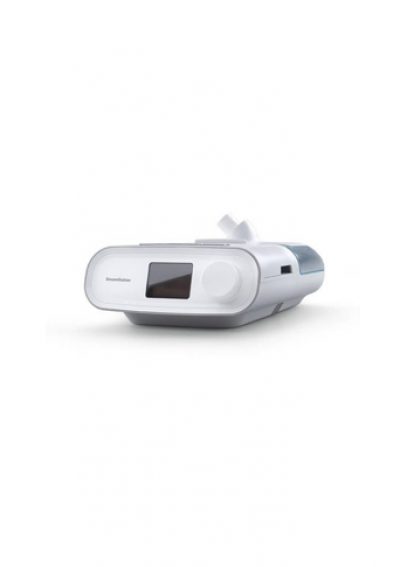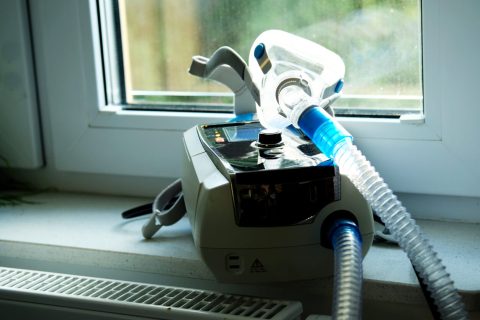CPAP Side Effects
The majority of CPAP side effects are mild, such as runny nose and dry mouth. Most side effects resolve when a patient gets used to their CPAP machine. However, Philips CPAP devices recalled in June 2021 have sound abatement foam that may cause side effects such as cancer and respiratory problems.

Common CPAP Side Effects
Philips CPAP machines and other CPAP machines share many of the same common, mild side effects. One of the most common side effects of CPAP treatment is nasal congestion.
When patients first begin treatment, they may have difficulty getting used to sleeping with the mask, have trouble sleeping or experience throat or nose discomfort. Some people may experience a feeling of smothering while wearing the mask.
There is a small risk of respiratory infection with CPAP treatment. However, using a humidifier and properly cleaning the machine reduces the risk. When using a humidifier, always use distilled water instead of tap water. Distilled water is free from bacteria and minerals and reduces the risk of infection.
Make sure you communicate with your medical provider if you have side effects. They may be able to suggest another mask, adjust the pressure of the machine or recommend other sleep apnea treatments.
Nasal Congestion
Nasal congestion is one of the most common side effects of using a CPAP machine. CPAP therapy can cause changes in humidity, pressure, temperature and airflow rate that may contribute to congestion, and it may be worse in people with allergies.
However, studies also show that some people see an improvement in nasal congestion symptoms after using CPAP for at least three months, according to a 2020 study published in JAMA Otolaryngology-Head & Neck Surgery.
Dry Nose or Mouth
CPAP can cause changes in air pressure that can block the flow of saliva and mucus-producing glands. This leads to dry nose and dry mouth.
Lack of moisture in the nose can irritate and inflame nasal passages and tissues, causing nosebleeds. Dry mouth from lack of saliva may lead to scratchy throat, difficulty swallowing and overgrowth of bacteria, which may cause bad breath and gum disease.
Air Swallowing
Air swallowing, also called aerophagia, happens when pressurized air from the CPAP goes into the esophagus and belly instead of the airway and lungs. It can cause bloating and abdominal pain.
Aerophagia can happen to anyone using a CPAP. If it happens regularly, you should talk to your medical provider. Sometimes aerophagia happens when the pressure setting on the CPAP machine is too high or too low.
Skin Redness, Sores and Inflammation
CPAP users may suffer from skin redness, sores or inflammation. This usually occurs on the face around the mask, such as the bridge of the nose or on the cheeks.
A mask that doesn’t fit right or is too tight is typically the cause. In addition to sores, rashes or redness, ill-fitting masks can cause air to leak. Patients may try to tighten the mask to stop air leakage and make the sores worse.
Claustrophobia, Anxiety and Discomfort
CPAP claustrophobia is a natural occurrence for new CPAP users. A poor fitting mask or the wrong mask type most often causes it, but the wrong pressure setting can also contribute to it.
Wearing the CPAP mask may cause some people to feel smothered and struggle to breathe. This causes the body to release adrenaline. If it happens often enough, it may trigger a panic attack.
5 Tips for Managing CPAP Side Effects
Although most CPAP side effects are mild, they can be bothersome and cause people not to adhere to treatment. Insufficiently treated sleep apnea can cause other health problems, so it’s important to be patient with CPAP treatment.
Many patients get used to the machine with regular use. Your doctor can adjust the pressure to help you work through your discomfort and help you find the right CPAP equipment. These tips below can help minimize side effects. If you still can’t tolerate CPAP treatment, your doctor may recommend CPAP alternatives such as surgery or implants.
1. Use a Properly Sized Mask
A properly fitted and sized mask will help you avoid air leaks and face discomfort. It will also reduce feelings of claustrophobia. The mask should feel comfortable and secure. People who breathe through their mouth may want to consider a chin strap to reduce air swallowing.
2. Regularly Clean Your CPAP
Regularly cleaning your CPAP will prevent bacteria build up and may reduce respiratory symptoms and infections. Make sure to only use approved cleaning products to clean your CPAP.
Most manufacturers recommend cleaning your CPAP equipment at least once a week. If you are sick or have a respiratory infection, you should clean it daily. Use soapy, warm water, rinse the equipment well and let it air dry.
3. Adjust Your CPAP’s Settings
The wrong pressure settings may cause breathing discomfort, claustrophobia and anxiety as well as difficulty sleeping. Make sure to discuss this with your doctor. They can adjust the machine for you.
It may take more than one try to get the pressure setting right. You may also try a machine that has a ramp up feature to gradually let you get used to the pressure. BiPAP machines have a different pressure setting for when you breathe in and when you breathe out.
4. Humidify & Use Saline
Pressurized air from a CPAP enters the airway faster than the nose can warm it up to make it comfortable to breathe, especially if you live in a cold, dry climate. Humidifiers warm up the pressurized air to help avoid dry mouth, dry nose and nosebleeds. Some CPAP machines come with them already built in, but you can purchase one separately.
Purchase and use a saline nasal spray. Using this spray a few times into each nostril before using your CPAP machine can help prevent a stuffy, dry nose.
5. Wear Your CPAP a Little at a Time
Many CPAP side effects occur when people first start using their machines. Experts recommend wearing it for a short time during the day without turning it on. This will help you get used to wearing the mask.
Next, try wearing it with the machine on while you take short naps. Then, you can work your way up to wearing it while you sleep. Using a nasal pad under the mask may prevent redness and pressure sores. Try to find the best sleeping position that is comfortable for you. If you have prolonged problems sleeping or anxiety when wearing the mask, talk to your medical provider.
Philips CPAP Machines Linked to Cancer
In June 2021, Philips issued a CPAP recall for millions of its breathing machines because sound abatement foam in the machines could break down. This damaged polyester-based polyurethane (PE-PUR) foam could enter a CPAP user’s body through the nose and mouth, exposing them to toxic foam particles and gases.
“The potential risks of particulate exposure include irritation to the skin, eye, and respiratory tract, inflammatory response, headache, asthma, and toxic or carcinogenic effects to organs, such as kidneys and liver,” according to the FDA.
People who used recalled Philips CPAP machines and suffered injuries, including respiratory problems, organ damage and various cancers, have begun filing Philips CPAP lawsuits. They allege that Philips manufactured a defective product and didn’t warn the public.
In a preliminary foam testing update on June 28, 2022, Philips said chemical emissions from the foam are unlikely to cause health problems. The company also said ozone cleaners increase the chance of foam degradation.
The FDA reports that between April 1, 2021 and December 31, 2022 more than 98,000 medical device reports of side effects were received. These include incidents of, pneumonia, cancer, respiratory problems, asthma, infection, cough, headache, breathing problems, dizziness, chest pain and nodules. The reports also included 346 deaths.
9 Cited Research Articles
Consumernotice.org adheres to the highest ethical standards for content production and references only credible sources of information, including government reports, interviews with experts, highly regarded nonprofit organizations, peer-reviewed journals, court records and academic organizations. You can learn more about our dedication to relevance, accuracy and transparency by reading our editorial policy.
- Park, A. (2022, June 29). Philips attributes foam breakdowns in recalled CPAP ventilators to ozone-based cleaners. Retrieved from https://www.fiercebiotech.com/medtech/philips-reports-foam-breakdown-only-4-recalled-ventilators-linked-formal-complaints
- Philips. (2022, June 28). Philips provides update on Philips Respironics’ PE-PUR sound abatement foam test and research program. Retrieved from https://www.philips.com/a-w/about/news/archive/standard/news/press/2022/20220628-philips-provides-update-on-philips-respironics-pe-pur-sound-abatement-foam-test-and-research-program.html
- U.S. Food and Drug Administration. (2021, September 10). Certain Philips Respironics Ventilators, BiPAP, and CPAP Machines Recalled Due to Potential Health Risks: FDA Safety Communication. Retrieved from https://www.fda.gov/medical-devices/safety-communications/certain-philips-respironics-ventilators-bipap-and-cpap-machines-recalled-due-potential-health-risks
- Ma, Z. et al. (2020, September 28). Development of a smart-fit system for CPAP interface selection. Retrieved from https://journals.sagepub.com/doi/10.1177/0954411920959879
- Skirko, J.R. et al. (2020, April 9). Association of Allergic Rhinitis With Change in Nasal Congestion in New Continuous Positive Airway Pressure Users. Retrieved from https://jamanetwork.com/journals/jamaotolaryngology/fullarticle/2764149
- Grau-Bartual, S. (2020). Effect of continuous positive airway pressure treatment on permeability, inflammation and mucus production of human epithelial cells. Retrieved from https://openres.ersjournals.com/content/6/2/00327-2019
- Sleep Apnoea Trust Association. (2020). Dealing With CPAP Claustrophobia & Panic Attacks. https://sleep-apnoea-trust.org/wp-content/uploads/2022/03/Dealing-with-CPAP-Claustrophobia-and-Panic-Attacks-A4-Aug-2022.pdf
- ResMed. (n.d.). Why Use a CPAP Humidifier? Retrieved from https://www.resmed.com/en-us/sleep-apnea/sleep-blog/why-use-a-cpap-humidifier/
- American Sleep Apnea Association. (n.d.). Aerophagia Causes and Resolutions. Retrieved from https://www.sleepapnea.org/treat/cpap-therapy/troubleshooting-guide-for-cpap-problems/aerophagia-causes-and-resolutions/
Calling this number connects you with a Consumer Notice, LLC representative. We will direct you to one of our trusted legal partners for a free case review.
Consumer Notice, LLC's trusted legal partners support the organization's mission to keep people safe from dangerous drugs and medical devices. For more information, visit our partners page.
844-420-1914



